How to Build a SaaS Product Roadmap: Tools, Technics, Steps
Consistency and stability are essential in developing any product. This is especially true for SaaS products, where the team faces the need for frequent updates, migrations, etc.
The product manager's task is to create optimal conditions for the team's work and keep in touch with stakeholders. This can only be done if the process is optimized and divided into clear phases. There are many techniques and tools for this; the most practical among them is the product roadmap.
In this article, we’ll discuss the purpose and importance of such documents, and consider their types, features and techniques for prioritizing. We’ll also take a look at some relevant SaaS product roadmap examples and the best tools for their creation.
Why SaaS Product Roadmap Is So Important
A product roadmap is a visual representation of a product's development path and the efforts that this process requires. This is a guideline for the team and stakeholders that describes the course and goals of the project.
Usually, the saas product development roadmap includes:
- product vision and strategy, methods of their implementation;
- priorities (short-term and long-term);
- time frames;
- indication of progress (current and expected);
- desired and planned functionality.
In other words, this is a living and dynamic document that contains all the important data for structuring and organizing an effective development process.
Why Is The Roadmap Important?
The product-creating process is complex and time-consuming; it requires precise planning and definition of the right goals. A roadmap is a tool for illustrating where the team will go and why, and this will show what effort will be required to create the product, link the strategy and efforts to implement it.
The roadmap is also essential, as it allows you to understand the impact of your actions and decisions, as well as to communicate more easily with the participants in the process, including stakeholders. This tool helps not only to illustrate but also to support the product vision, development priorities and strategy.
The roadmap is also important for
- Increasing the level of transparency.
- Keeping everyone involved in the process informed.
- Creating a clear and visible action plan.
- Assessing capabilities and resources.
Creating a roadmap also helps to motivate the team and inspire them to high performance because each member sees the purpose and goals of their work.
How Product Roadmaps Are Used By Other Teams
There is no one-size-fits-all roadmap, and here is why. Engineers need deep specifications and more technical information, while investors, for example, pay more attention to business capabilities and have no need to delve into technical details.
So, you will have to create at least two versions of roadmaps (actually, more) for different audiences. These will be tools for internal and external use.
Internal SaaS Roadmaps
For internal use, you need to create roadmaps that will be helpful to members of the development team, marketing and sales managers, etc.
- Roadmaps for developers. All technical-level information, specifications and feature list, specific time frames for each stage of development, technologies involved, etc. It is task- and goal-oriented.
- Roadmaps for the C-suite Executive. Include important strategic aspects, long-term project goals and how they are implemented using distributed tasks, time frames and analytical information.
- Roadmaps for marketers and the sales department. The end user's pain points, needs, and desires, which the product can satisfy, the end-customer portrait, target audience, etc. With the help of a roadmap, marketers can form an effective promotion strategy and the sales department – a picture of the value and benefits of the product.
SaaS product roadmap example
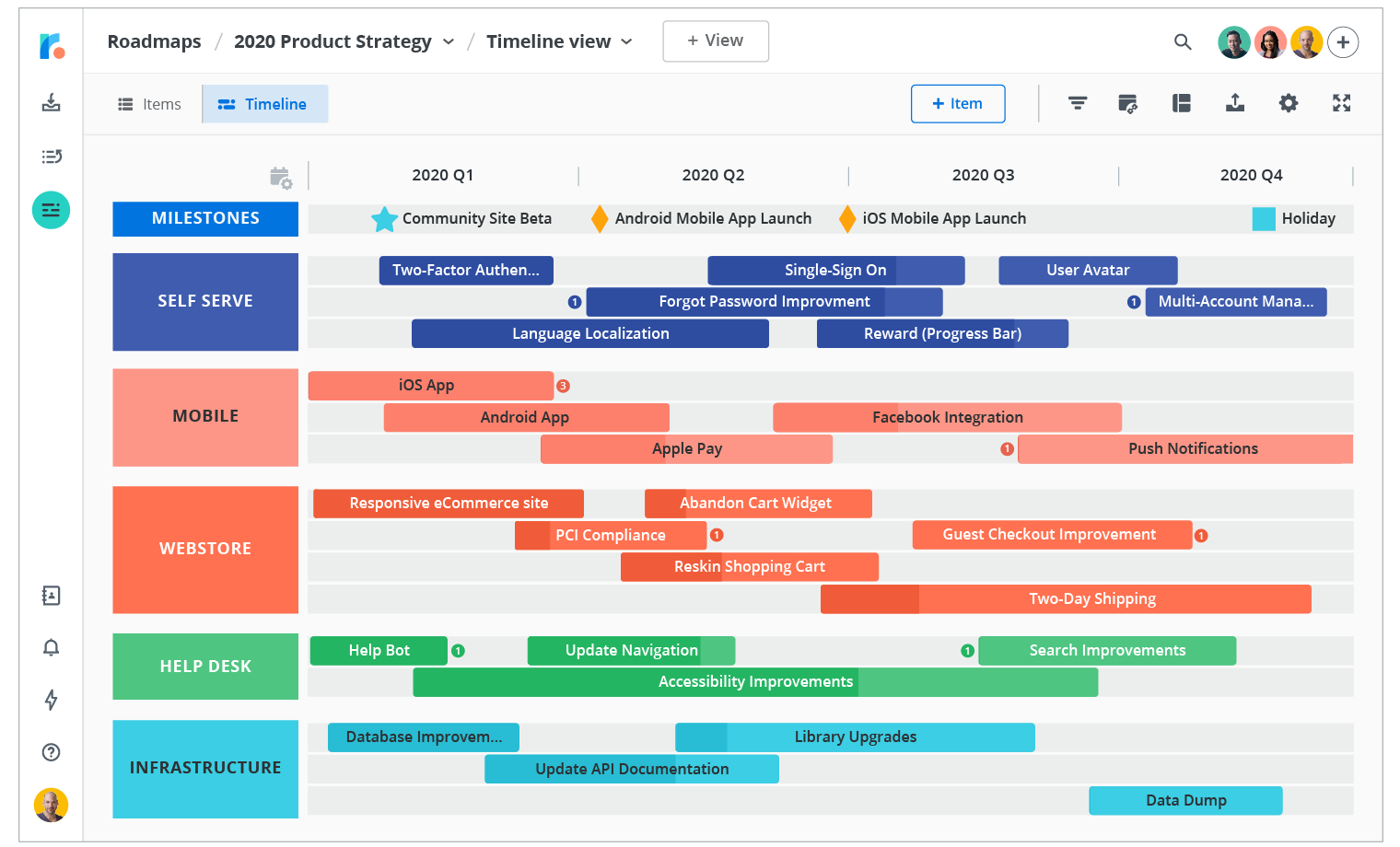
External SaaS Roadmaps
External roadmaps are created for investors, existing and potential customers, etc. They must maintain a precise information balance to interest external users and not lose their attention due to an excessive amount of specific data. In addition, they mustn't contain information that could become a weapon in the hands of competitors.
This kind of presentation tells an exciting story about product creation and demonstrates its value, unique features and some technical subtleties. Its purpose is to attract additional resources, interest the audience, and increase product awareness.

Streamline Your SaaS Product Roadmap with SaaSBuilder
Struggling to create a comprehensive roadmap for your SaaS product? SaaSBuilder offers a range of tools and templates to help you streamline the process and stay on track. Discover how SaaSBuilder can help you today.
SaaS Roadmap Types & Examples
There are many roadmaps, and they all have their own goals, structure and functions. Let’s discuss the most common options in more detail.
Feature-based Roadmap
As the name implies, a SaaS feature-based roadmap is about gathering key features and monitoring their development. It’s necessary for determining the priority of each separate feature, tracking releases and proper allocation of resources.
Such a document may require corrections along with the development of technologies and changing trends. It is a good practice to sort features by priority, time intervals, and technical indicators.
Goal-oriented and Theme-based Roadmaps
Clearly defined goals explain your strategy to development participants and answer the question "why?" when it comes to features, changing the tech stack, requiring new resources, etc.
Such a roadmap allows you to structure a large amount of information into concise segments that explain issues and ways to solve them. This helps to demonstrate to the company's top management the laboriousness and amount of work performed.
The essence of a theme-based roadmap is the grouping of several similar goals into one unit. It allows you to determine the main development directions and divide the work process into thematic segments. Such roadmaps give a clear understanding of what the product is being developed for and what the end result should be.
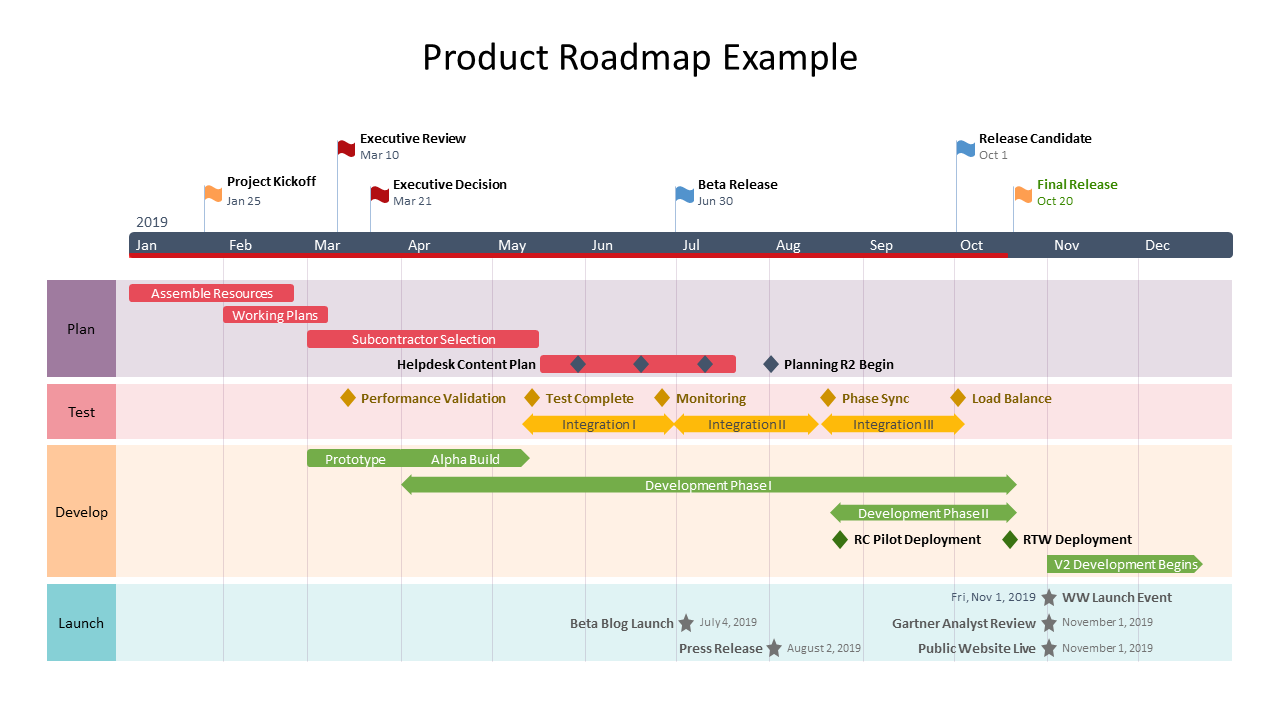
Now-next-later Roadmap
This is one of the simplest types of SaaS product roadmap, which allows you to follow the team's progress and clearly define the priorities of some tasks or features. Thus, members of the development process understand their work progress and capabilities and see which tasks should be taken care of first.
Usually, such a map consists of three simple columns: now, next and later.
- Now. Tasks for the near future, as well as goals that should be paid attention to first.
- Next. Goals and tasks for other several weeks or after the end of the sprint.
- Later. Long-term goals and plans are indicated here.
Such a roadmap may contain more details and descriptions. It all depends on the team's needs and the project's scope.
Technology Roadmap
These are internal roadmaps created primarily for the design or development team. This allows you to demonstrate the technical requirements and means of their compliance, the tech stack as a whole, and the value of individual technologies, tools, and frameworks.
In other words, they are structured lists of technical details and specifications that help you see exactly what is being used and for what business purposes. A good practice is to distribute them in separate sectors depending on the use purpose (security, payment, user interface, etc.).
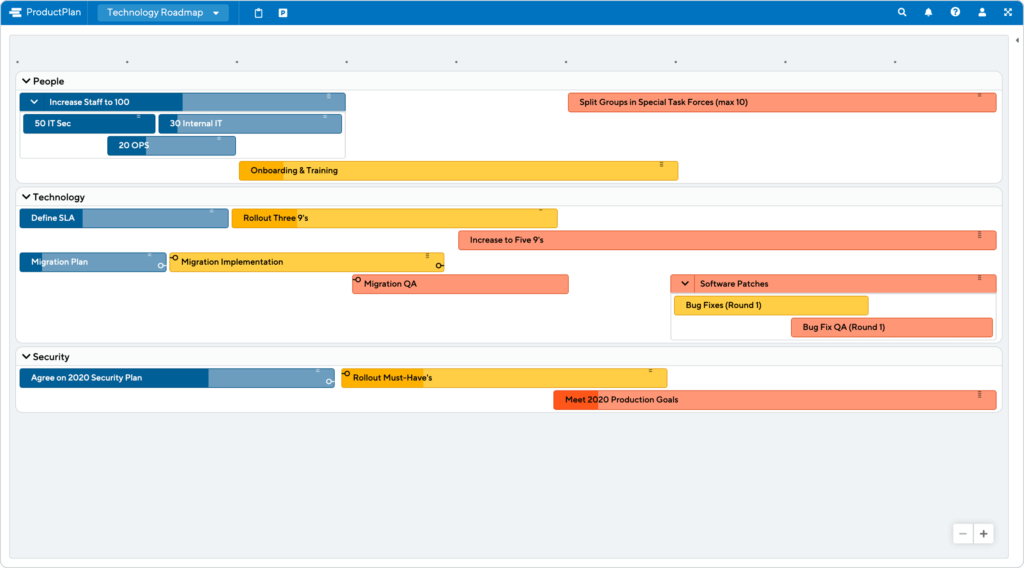
Source: ProductPlan
Release Roadmap
This SaaS roadmap variation shows exactly what needs to be done before the product release. It can be a list of features, bugs to fix, required updates, etc., and all of this should be sorted according to the time frame and the persons responsible for the task.
The roadmap helps coordinate the actions of each department before the release and precisely divides the areas of responsibility. This, in turn, dramatically optimizes the development process.
Portfolio Roadmap
A portfolio roadmap is needed for two purposes. First, it allows you to follow the development of various products that are related or have something in common (technology, goals, market, etc.).Second, it helps share details of various product strategies among stakeholders, managers, etc.
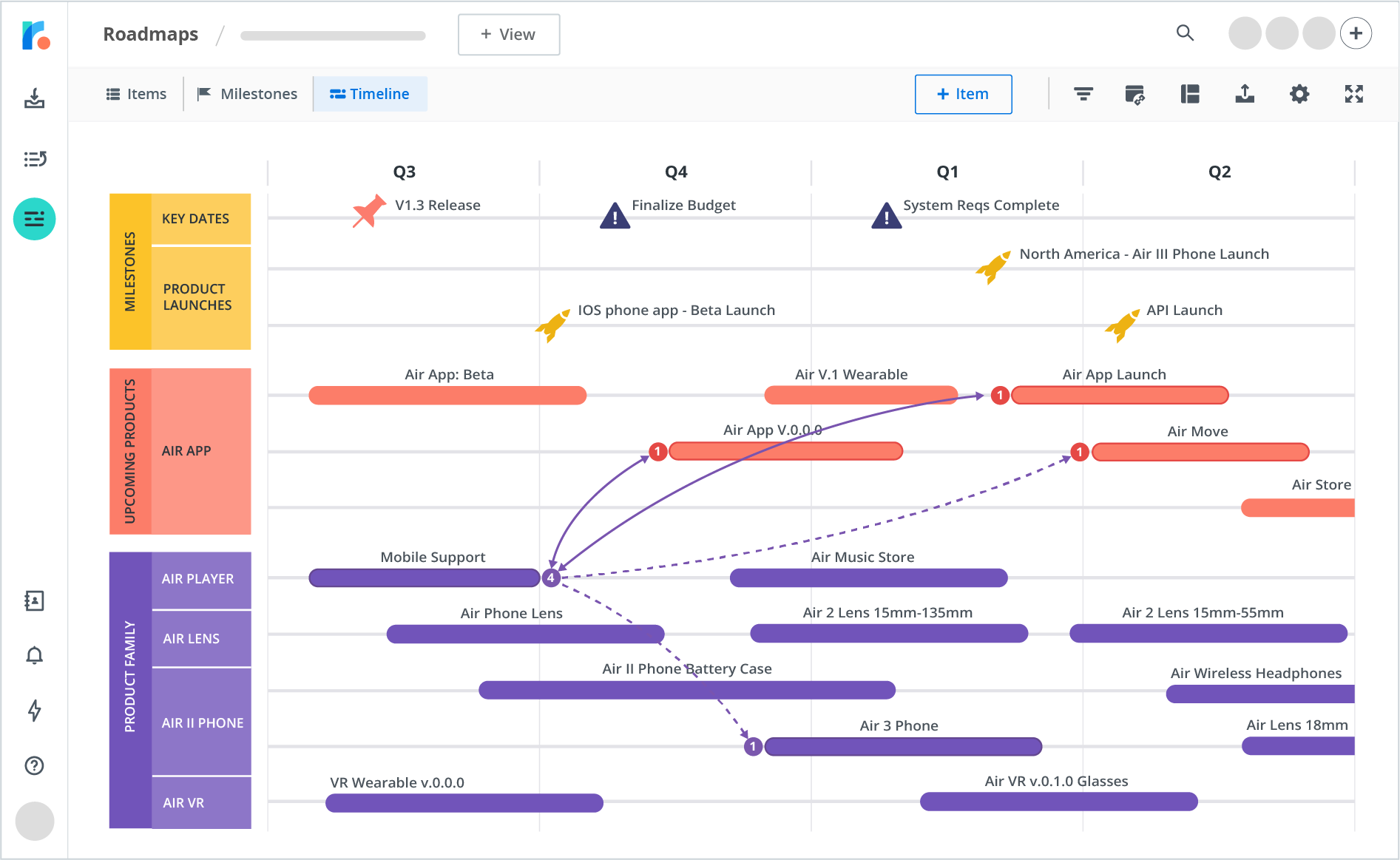
Source: Roadmunk
Strategy Roadmap
A strategy roadmap connects the company's strategic goals with the results that have to be achieved in the product development process. It can be a document for internal or external use. The first case may contain some technical and financial details; the second one should be more general.
This high-level diagram demonstrates the connection between the general product features and aspects of their use to achieve a specific goal. In other words, this is all about SaaS product strategy.
Market Roadmap
A market roadmap is necessary for the marketing and sales departments and internal stakeholders as it is used for marketing strategy planning. Such documents are very dynamic and may change depending on market trends.
A market roadmap is also required if the product is launched in several markets at once. This makes it easier to establish the main points, define goals and monitor the effectiveness of marketing efforts.
Source: Roadmunk
Steps to Create a SaaS Product Roadmap
Let's go through this process step by step.
Step 1. Short and Long-term Goals
Since a SaaS software roadmap is a way to organize the development process step by step, the approach to its creation, as well as to the definition of goals, should be based on a "bottom-up" system. It means that you should define long-term goals as the end result and short-term goals as steps towards it.
In other words, you must have a clear vision of the product and the actions it requires from you and the team. At this stage, it is crucial to specify the target audience, create user portraits, conduct a market analysis, etc. This will help to form the right goals and strategy.
Step 2. Stakeholders Inputs
Stakeholders' inputs are critical to any product development process. They can suggest for what purpose it is being created, why it should be developed right now and clarify its value. With this information, everyone involved in the process clearly understands the product.
Also, at this stage, marketing, sales, finance and technology departments usually interact with stakeholders. This is necessary to coordinate advertising strategies, budget, technical stack, etc.
Step 3. Prioritize All Features
Even the most concise and simple products have more than one function; some are more prioritized than others. The manager's task, in this case, is to determine the priority level for optimization and adjustment of the development process. Otherwise, you can get stuck and confused on the way.
It is good practice to use several solid frameworks for prioritization, and they allow not only to put things in order but also to effectively use business analysis services. Let's talk about them.
RICE
RICE means Reach, Impact, Confidence, and Effort, and it offers to evaluate each feature with these metrics.
- Reach: the number of users during a specific time period.
- Impact: rating on a scale of 1 to 5, with 5 being the highest.
- Confidence: from 1 to 100%.
- Effort: number of hours for feature creating and implementing.
Formula

PM can sort features by priority and estimate team efficiency based on this number.
Kano Model
The Kano model is a fairly complex but effective way of prioritizing features, as it allows you to evaluate them based on collecting and analyzing all essential metrics and data.
The PM compiles a list of important questions for feature evaluation, collects the answers, and creates a satisfaction scale or chart based on this result. Further, these data must be compared with investments in the creation of a feature and priority should be determined.

Source: ProductPlan
Value vs. Effort Ratio
This method consists of several essential steps.
- Definition of value. PM gathers data about what value means to all stakeholders (revenue generated by a feature, level of customer satisfaction, etc.) and finds a “middle ground” based on this.
- Determination of effort according to the same principle as value.
- Ratio calculation: divide the value by effort.
This coefficient helps prioritize features. However, it is worth remembering that proper determination of value and effort is incredibly important for such an approach. These metrics should fully match the needs of the business.
Story Mapping
The story mapping framework focuses on user interaction and helps the team better understand the needs and experiences of the target audience. With this approach, PM will create a chart with two axes:
- Steps in the customer journey in chronological order, from download/signup to completion of a specific task or feature.
- Priority degrees/time frames, etc.
This allows you to identify all important user interaction touchpoints and add new ones as needed.
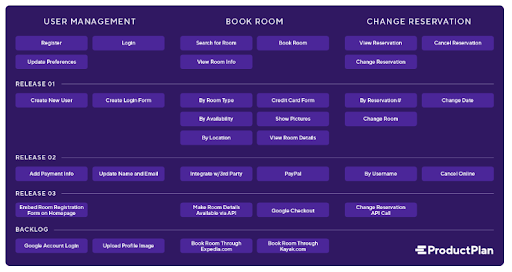
Source: ProductPlan
Step 4. Essential Timeframes
Setting a timeframe is a must for creating a roadmap for a new product. Since the roadmap is a development visualization, this part should be precise and clear.
Two types of timeframes are essential to consider in this regard. The first one is the time to complete individual tasks. Each step should have its own deadline, sometimes with a small margin in case of unforeseen situations. However, this reserve should not be large because the team must adhere to a clear schedule of sprints.
The second type of time frame is the time to the final destination of your roadmap. In other words, it’s all the time allocated to project creation, from initial actions to launch. This deadline should be clear and realistic. It’s also worth determining the priority of tasks in the created timeframe.
This approach helps monitor the effectiveness of the team and its individual members, control the process in general and make improvements as needed.
Step 5. Choose Specific Tools
The easiest tool for creating a product roadmap is Google Sheets. It’s free, requires no special skills and is available to everyone. However, it doesn’t offer features specifically for roadmaps, such as templates, for example.
In the case of SaaS products, it’s better to choose something like Jira roadmaps or Roadmunk. The first option is easy to integrate, provides different perks depending on the Jira Software Cloud subscription and has many features exclusively for working with roadmaps.
Roadmunk, in turn, offers a lot of specific templates for different types of roadmaps (strategy-based, portfolio, etc.) and chat for current tasks.
A less popular but quite good option is Aha!. This tool offers many features for customizing roadmaps and has a free version for startups. However, you should spend some time dealing with the interface.
ProductPlan is another good option. This tool has advanced integration with GitHub, Jira, Slack, Trello, Azure DevOps, etc. As for functionality, there are a lot of opportunities to customize templates, tasks chat and an ideas block.
Step 6. Outcomes and Key Results
One of the purposes of the roadmap is to monitor whether current actions are related to those planned for the future. It helps to assess work and understand whether is it consistent and effective. This is especially crucial for MVP development for startups.
For example, you can measure the number of app downloads before and after implementing specific features, which will give you an understanding of whether you are moving in the right direction.
The easiest way to determine this is to monitor Outcomes and Key Results, or OKRs. It is a marker that tells you what stage you are at and how successful your efforts are. It will help to set quarterly goals, adapt the roadmap to new ones, and monitor if each action brings real benefits.
Step 7. Move Your Roadmap into SaaS
Now you know how to create SaaS product roadmap, but how to share it with teams and stakeholders? The main task of this step is to make the roadmap accessible to all participants in the process. You can use Agile Board, Kanban, Planio, etc. It will bring all plans and strategies together in one place and make them accessible to anyone who needs them.
Your SaaS project management tools can also be used to check performance, OKRs, requests and their fulfillment, the connection between features and priority themes, etc.
Step 8. Keeping Roadmap Up to Date
Keeping the roadmap up to date is a must, especially in the b2b segment. It should be a dynamic document that adapts to new trends and situations. SaaS is a fast-paced, changing industry, so it's important to monitor whether you're moving in the right direction and adapting to the changing market landscape.
The frequency of updating depends on product scope and goals. If it’s MVP, it is enough to review the document every two weeks with a gradual increase in the interval.
In the case of advanced products, the update frequency could be increased to 1-2 months. Everything depends on changes within the company and the market.
Such a review will help monitor whether the roadmap is relevant, whether it still conveys a transparent product development vision, and whether team efforts are practical.

Things to Include In a Saas Product Roadmap
Many people get lost in creating a product roadmap for SaaS due to the abundance of tools and information available. Of course, the content of such a document depends significantly on its type and purpose. Internal roadmaps are more informative, while external roadmaps should be impactful and attention-grabbing.
There are a few basic elements that should be included in any roadmap.
- Features prioritized and agreed with all teams.
- All the values associated with the product.
- Business strategy.
- A clear and understandable progress tracking system (marks for planned and completed tasks, etc.).
- Informative descriptions (with the data gathered on the software product discovery phase).
- Deadlines and time frames.
The resulting roadmap must be a kind of guide that demonstrates achievements and the direction of further development.
Ardas's Expertise in Creating Product Roadmaps
So, the SaaS product roadmap is a visualization of the business strategy and the team's path from the first to the last stage of development. This document dramatically improves communication, helps organize the workflow and keeps stakeholders informed. It is also needed to track critical performance metrics and progress.
There are roadmaps for internal and external use, for development teams, marketing, sales, etc. Roadmaps also differ in the information they focus on. These can be feature-based, topic-based, information-based, portfolio or technical roadmaps, etc. All of them have their own goals and scope of use.
A quality roadmap is an integral part of any project's success. We at Ardas have extensive experience in creating such documents. Over the years, we have formed an optimal approach to designing roadmaps for projects of any complexity and scale. And our team will be happy to share this experience with you and consult you deeper on this topic. So feel free to hit the form below or contact us in any convenient way.
